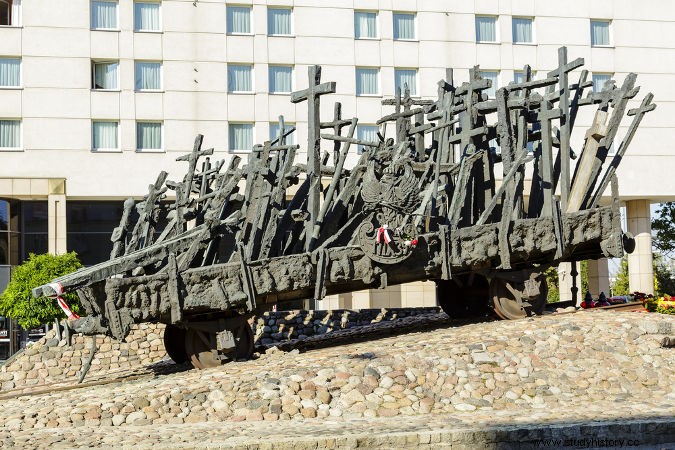
The Katyn Massacre it was a genocide that took place during World War II. It was carried out by the Soviet Union against Polish prisoners and is one of the little-known events of World War II. In all, some 22,000 Poles were killed. The massacre was publicized by the Nazis in 1943 as propaganda against the Soviet Union and bears the name of the Katyn Forest in reference to the bodies found there.
Invasion and division of the Poland
Poland was one of the countries that suffered the most from the Second World War. Germany and the Soviet Union conspired against Poland, which resulted in an agreement called the German-Soviet Pact. The pact, in addition to determining that Germany and the Soviet Union would remain at peace in the event of war in Europe, also stipulated the invasion and division of Poland between them.
The German invasion began on September 1, 1939, which started World War II. Polish armies were quickly defeated by Nazi troops. The Soviet invasion of Poland was consolidated on September 17, 1939. Soviet troops claimed that this invasion was a peace mission to guarantee the security of Ukrainian and Belarusian minorities.
From there, Poland ceased to exist. Part of its territory was occupied by the Germans and another part was occupied by the Soviets. The Polish soldiers who were in the part invaded by the Soviet Union were promptly surrendered and, in 1939, a process of deportation was initiated. from Poles to prison camps or forced labor camps in different parts of the Soviet Union.
Among these prisoners were about 15,000 Polish army officers, most of them reservists. The reservist officers of the Polish army were, by and large, politicians, scientists, lawyers, university professors – in short, the Polish intellectual elite – and were considered a risk to the Soviet Union and therefore imprisoned.
Massacre

Josef Stalin was convinced by Lavrenti Beria to order the execution of Polish prisoners **
With the arrest of the Polish intellectual elite, the Soviet Union placed Polish communists in power in the new territories and began to absorb the new citizens, forcing them to adhere to Soviet citizenship.
P>The 15,000 Polish officers were grouped into three prison camps:Kozelsk , in Ukraine, near the city of Smolensk, and Ostashkov and Starobilsk , located in Soviet Russia. All three camps were administered by NKVD (Narodniy komissariat vnutrennikh diel or People's Commissariat for Internal Affairs, in Portuguese), the Soviet secret police.
The massacre was masterminded by the head of the secret police, Lavrenti Beria, which convinced Stalin that the prisoners were members of counterrevolutionary groups and therefore posed a risk to Soviet control in Poland. With Stalin's authorization, Beria organized a special committee, called the troika , to select the prisoners who would be sentenced to execution.
The selection made by the NKVD had the following structure:
-
14,500 of the 15,000 officers were sentenced to death;
-
3,000 prisoners in western Ukraine;
-
3000 prisoners in western Belarus;
-
1,305 other people who were free and considered dangerous.
Only 500 officers escaped the shooting and, according to Timothy Snyder, “the exceptions were some Soviet agents, people with German and Latvian ethnic backgrounds, and those with foreign protection |1| .
In all, 21,892 were killed Polish prisoners, being:
-
6,314 officers arrested in Ostashkov;
-
3,739 officers arrested in Starobilsk;
-
4,410 officers arrested in Kozelsk;
-
7,429 other Polish prisoners.
Prisoners were transported in small groups to the corresponding places of execution and were shot in the back of the head, then buried in mass graves. These graves were found by Nazi troops in 1943. The Nazis called in numerous coroners, who exhumed the bodies and found evidence of execution. The case was used as propaganda by Germany against the Soviet Union, which immediately denied responsibility for the massacre.
Only in 2010 Russia assumed Soviet and Stalin responsibility in the Katyn massacre after the ruling of the Russian parliament.
|1| SNYDER, Timothy. Bloodlands. Rio de Janeiro:Record, 2012, p.177.
*Image credits:Marekusz and Shutterstock
**Image credits:Bissig and Shutterstock
by Daniel Neves
Graduate in History
